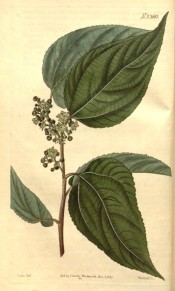Hovenia dulcis Thunb.
Fully hardy, upright then spreading tree with generally heart-shaped , toothed, glossy leaves, to 20cm long, downy beneath, and cymes, to 7cm across, of tiny, greenish flowers in summer. After flowering the stalks swell, becoming reddish, and are fleshy, sweet and edible. To 12m. [RHSE, Hortus, Hilliers’].
Horticultural & Botanical History
‘Hovenia dulcis is cultivated in Japan and China for the sake of its singular sweet fruit, as in common language it is called, though, it does not afford any covering to the seed, as most fruits do; but no more does the common strawberry, the succulent, eatable part of which is the enlaged receptacle, on the outside of which the seed is affixed. So in this plant, after the flowering is over the branched foot-stalks of the flowers increase in size, become succulent and contain a sweet pulp which Kaempfer compares to the taste of our Bergamot pear. To the succulent extremities of the branched foot-stalk, the capsule containing three seeds in three cells is attached by a short pedicle.’ [BM t.2360/1822]. Introduced to Europe in 1812. [Don].
History at Camden Park
Listed in the 1850 and 1857 catalogues [T.559/1850]. Macathur may have imported this tree more for its culinary properties than its value as an ornamental tree.
Notes
Published Mar 04, 2009 - 04:59 PM | Last updated Jul 30, 2010 - 04:53 PM
| Family | Rhamnaceae |
|---|---|
| Category | |
| Region of origin | Southern Asia |
| Synonyms | |
| Common Name | Raisin tree |
| Name in the Camden Park Record | Hovenia dulcis |
| Confidence level | high |


